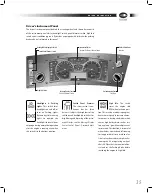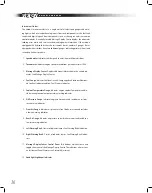
47
d r i v e r
o r i e n t a t i o n
Parking Brake, Units With Hydraulic Brakes
Blue Bird Vision buses equipped with hydraulic brakes are also equipped with a
drum/shoe-type brake mechanism mounted to the driveline at the rear of the trans-
mission. When applied, the park brake prevents the driveshaft from turning.
A control cable leads from the parking brake mechanism to a foot pedal in the
Driver’s area immediately left of the brake pedal, just beside the steering column.
To apply the parking brake, press down firmly on the
foot pedal. When properly adjusted, the lever is designed
to require between 130 and 150 pounds of pressure to
apply the parking brake. Always apply the brake fully,
pressing it down to achieve a fourth “click” of its detent
setting.
To release the parking brake, apply the service brake
with the left foot to prevent movement when the park-
ing brake is released. Then grasp the parking brake re-
lease lever with the left hand and pull until the Park Brake
is fully released.
[CAUTION]
Always release the parking brake fully.
Leaving it in a partially released position can allow
the shoes of the parking brake mechanism to drag
while the bus is operated, resulting in overheating
and accelerated wear of the parking brake shoes and
drum.
Optionally, your bus may be equipped with a right side parking brake lever. This op-
tion places the hand operated parking brake to the right of the driver’s seat mounted
on the floor.
To apply the parking brake, grasp the grip handle of the lever and pull firmly
upward. When properly adjusted, a detent resistance is felt at the end of the lever’s
travel. The lever is designed to require 90-100 pounds of pressure to fully apply the
parking brake. Always apply the brake fully, pulling it upward to the full extent of its
travel.
To release the parking brake, apply the service brake with the left foot to prevent
movement when the parking brake is released. Then grasp the parking brake lever
with the left hand, press the thumb release button on top of the grip and lower the
lever
fully
all the way against its lower stop.
The parking brake lever’s grip incorporates a threaded adjustment mechanism to
allow a service technician to make fine adjustments to the cable tension. The adjust-
ment is made by loosening a set screw in the grip handle and then rotating the grip
on its shaft. This adjustment is designed to be performed in the service facility, not
during normal operation of the bus. During normal operation, the grip should not be
free to rotate. If the Driver ever finds the grip free to rotate when applying or releas-
ing the lever, it should be taken as indication that the setscrew is not properly tight-
ened. This condition should be reported to service personnel, and proper adjustment
and tightening should be performed.
Release Handle
Pull to release.
Foot Pedal
Apply the brake fully, pressing it down to
achieve a fourth “click” of its detent setting.
Park Brake Hand Lever
90 -100 lbs. force
Summary of Contents for VISION 2011
Page 1: ...10013333 2011 BBCV D R I V E R S H A N D B O O K 10013333 BBCV BLUE BIRD VISION 2011 ...
Page 2: ......
Page 3: ...10013333 Revision B ...
Page 8: ...VISION D R I V E R S H A N D B O O K 6 ...
Page 26: ...VISION D R I V E R S H A N D B O O K 24 ...
Page 70: ...VISION D R I V E R S H A N D B O O K 68 ...
Page 137: ...135 Notes n o t e s ...
Page 138: ...VISION D R I V E R S H A N D B O O K 136 Notes ...
Page 139: ......
Page 140: ...10013333 2011 BBCV D R I V E R S H A N D B O O K 10013333 BBCV BLUE BIRD VISION 2011 ...






























